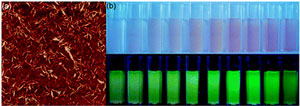Cellulose nanocrystals can be transformed into pH sensing nanoparticles by dual fluorescent labelling employing a one-pot procedure, explain scientists in the UK and Denmark.
In particular, Wim Thielemans, Jonathan Aylott and co-workers from the University of Nottingham alongside colleagues from the University of Southern Denmark, have shown that the thiol–ene click reaction can be used to modify the cellulose nanocrystals surface, leading to many future applications in sensing or tissue engineering.
Fancy finding out more? Download the article today and blog some comments on the science below. The communication has been published in ChemComm where it will be free to access until the 9th December.











